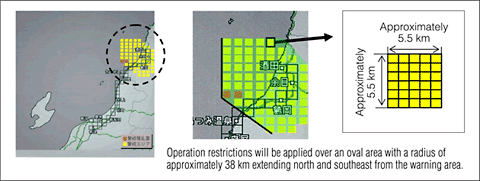Press Releases(Archive)
Initiation of Trial Operation of System Utilizing Meteorological Information for Operation Restrictions
Attachment 3
Forecasting methods
- An exhaustive study was made of localized strong winds on the Japan Sea coast that occur with the approach of winter cold fronts. The study used cases from 2001 to 2006, a period for which the Meteorological Agency has detailed weather data.
- The results showed that localized strong winds are often caused by cold fronts and tend to cause serious damage, and that they occur more frequently in coastal areas. These findings were scientifically analyzed.
- It was decided, based on the above results, to identify cases of intensity, height, and spread that ended in particularly severe damage, and to enforce operation restrictions accordingly on a trial basis.
Conceptual approach to operation restrictions
-
Operation restrictions were associated with intensity, height, and spread of cumulonimbus clouds as provisionally identified below, and used in judging whether or not trains should operate.
(1) Cold front presently passing through (2) The area where the cumulonimbus precipitation intensity (cumulonimbus cloud intensity) is 80 mm/hour or greater occupies a cluster of 10 or more squares, each approximately 1 km square (total approximately 10 km2). (3) The top altitude of cumulonimbus clouds (height of a cumulonimbus cloud) is 6000 m or more.
- Given the speed of cumulonimbus cloud movement, it has been decided to extend the range for enforcement of operation restrictions to an oval area with a radius of approximately 38 km extending north and southeast from the location that meets above conditions (1) to (3).
-
Implementation of operation restrictions
-
Operation restrictions are to be implemented as shown:
• Sections : Uetsu Line, Hakushin Line, Niitsu, between Niigata and Sakata • Beginning date : January 2008, during winter (limited to November through March) • Method : (1) Meteorological information from Meteorological Agency observation will be processed by a meteorological information company, tailored for JR East, and transmitted to the JR East Transportation Operation Center. (2) On receiving the information, the Transportation Operation Center will take steps to stop any trains that are within the area where operation restrictions are to be enforced. (3) Operation will be restored after values drop below the guideline levels.
-
Range of enforcement of operation restrictions
